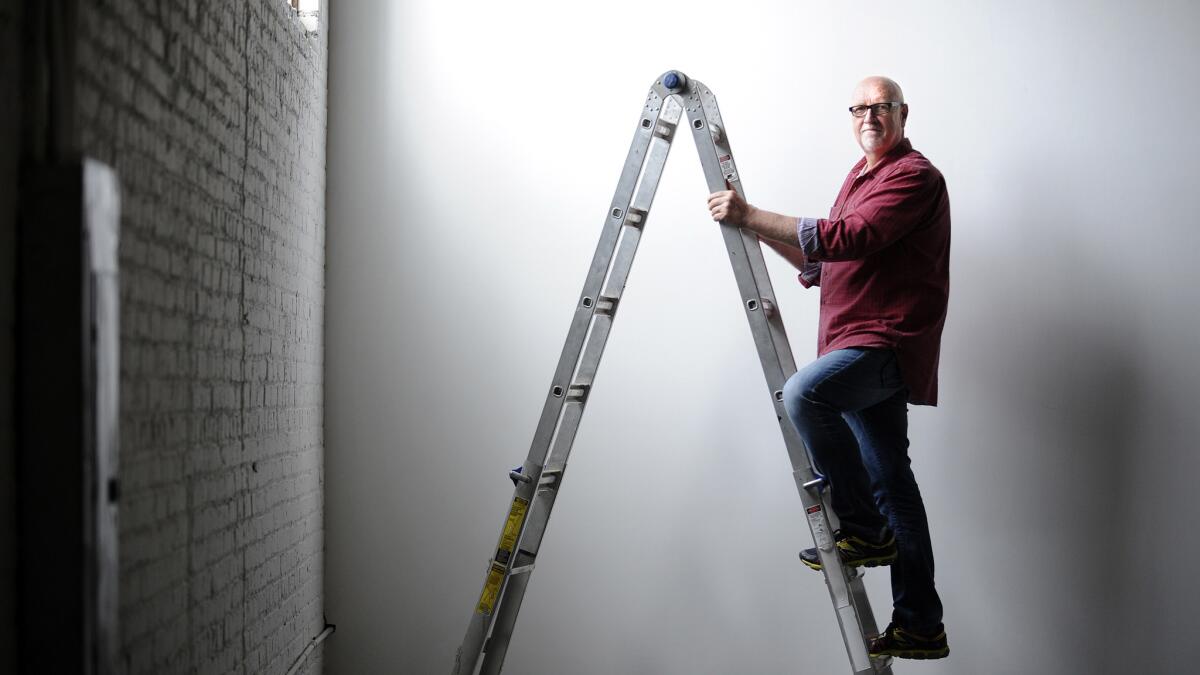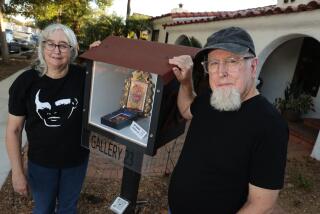The fall and rise of Clyde Beswick and his CB1 Gallery’s new downtown digs

- Share via
Clyde Beswick is not your stereotypical art dealer. He is not into scene-making or air kissing or gray power suits. He’s easy-going and personable, and you’re much more likely to find him in red flannel or bright gingham. He’s the type of dealer who runs a gallery because he relishes spending time around art and artists.
Art, Beswick insists, is “not a commodity. I’m not selling food,” he says. “I can’t get involved if I don’t fall in love with what I’m showing.”
Galleries are not easy propositions. It can be a juggling act of finding artists, installing shows and alerting the public. There are critics to contend with, the public’s fickle tastes and the endless fluctuations of the market. It’s no surprise that spaces come and go like the tides.
For the last five years, however, Beswick’s CB1 Gallery in downtown L.A.’s historic core, has been quietly nurturing the careers of a wide range of emerging and mid-career artists, figures who aren’t superstars — at least not yet — but who are nonetheless consistently producing compelling and important work. This includes the likes of Los Angeles artists Lisa Adams, who is known for scrambling abstraction with elements of the Southern California landscape in her canvases, and Lorenzo Hurtado Segovia, who makes majestic weavings out of bright paper.
Now Beswick is moving CB1 to bigger and better digs inside a former soap factory on Santa Fe Avenue just south of the Arts District. On Saturday afternoon, the gallery will pull back the curtain on its new 4,500-square-foot space with a pair of shows by painter Laura Krifka (known for her sumptuously raw figure paintings) and the sculptor André Goeritz (who leans toward the meticulously abstract).
The gallery joins a cluster of other arts spaces that have migrated to the area around the intersection of Santa Fe Avenue and East Washington Boulevard, a ruggedly industrial neighborhood studded with waste management operations, humming machine shops and at least one knick-knack store selling LED signs that blink “TACOS.”
In the immediate vicinity are The Mistake Room, Francois Ghebaly and the buzzy Night Gallery. And nearby are other exhibition hotspots such as 356 Mission and The Box. The move, in other words, will put CB1 in a place where art and artists are quite likely to be.
“For me,” says Beswick, “it’s really about context and community.”
The path that Beswick traveled to get to this place is rather fascinating, one that took him from marketing executive to art collector to art gallerist — with a short pit-stop in prison in between. (He was convicted of embezzling and filing false tax returns in 1997 and served a little more than 13 months in county jail and state prison.)
“It’s been almost 20 years since that happened,” he says ruefully. “I don’t want to relive that experience, but I am a better person for having had that experience.”
It is 10 days away from the grand re-opening of CB1 and the moan of drills and clanging of hammers can be heard echoing throughout the new gallery. The towering Beswick (he is 6’4”) remains relaxed as he cruises around electrical cords and ventilation tubing. He shows off the various display areas, including a video projection room and a pop-up gallery that will be used for independently curated exhibitions.
“It’s very flexible,” he says of the space. “I can do three show or one or two.”
Beswick was born and raised in the suburbs of Philadelphia and spent a good portion of his professional career working in various marketing positions in New York City. It was a friend, in the early 1980s, who suggested he collect art.
“She said, ‘You’re making good money now, you should buy some art,’” he recalls. “I told her I didn’t know enough to buy art. She said, ‘Just look.’”
Beswick says that he had always gone to museums and galleries. But it was at that point that he really began to take up art as a serious pursuit — studying the work of different artists, their trajectories, their materials. When his company moved him to Los Angeles in 1984, he immediately began to frequent the city’s museums and galleries.
“It was my way of getting familiar with the city,” he says.
And it was at this point that he began to seriously collect. Rosamund Felsen, the long-time Los Angeles gallerist, remembers Beswick’s first visit to her namesake space, which was then located on La Cienega Boulevard. (She is now in Santa Monica.)
“He came in and spent a great deal of time looking at each piece,” she says. “Then he came to me and said, ‘I’ll take that one and that one.’ I was so surprised. That never happens!”
Beswick became a regular at Rosamund Felsen, as well as Stuart Regen (now Regen Projects), LA Louver and Shoshana Wayne. His focus was young contemporary artists: “I didn’t buy billion dollar work. If I spent $5,000 I’d freak out.”
In this way, he amassed early pieces by key L.A. artists, such as photographer Catherine Opie, known for her striking fetish pictures, as well as Lari Pittman, who produces deeply layered canvases that fuse decorative patterns with modern themes.
In the early 1990s, Beswick helped fund the fabrication of sculptor Paul McCarthy’s now well-known “Tomato Head” series, which shows a rather despondent male toy figure bearing a tomato-shaped head.
“I gave him the money to make it and he gave me one,” recalls Beswick. “We put the ‘Tomato Head’ in this loft area where it overlooked our home. Then I had Opie’s ‘Pervert’ [which shows the artist in a bondage mask] over the fireplace. People thought it was so weird.”
Over a period of roughly a dozen years, Beswick amassed a collection of more than 700 works.
“It didn’t matter to him who else had purchased the work or how many exhibitions the artist had,” Felsen says. “It had to do with this appreciation of art from the standpoint of intelligence and aesthetic.”
All of that came to an end in the late 1990s when Beswick was sent to prison. At that point, he was a partner at Brody Smythe Direct, a direct mail company in Pasadena that he had helped found. He says that his downfall was using company funds to buy art. Rather than listing the art as an asset (which would have required him to pay taxes on each piece), he put it down as an expense (a tax deduction).
“I was traveling the world, drinking good wine and having great meals,” he recalls. “And the next moment I’m sleeping on a piece of foam on a metal slab.”
Beswick lost of all of his assets, including his art collection (which was purchased in its entirety by tech magnate Peter Norton). He then spent 13 months bouncing between county jail and a pair of state prisons, where he read dozens of books and worked in the library. But he says the whole experience was an important lesson.
“I really screwed up,” he says. “And I paid for my mistake.”
But if art had indirectly landed him in prison, it also helped get him out. It was through art world connections that he was able to land a marketing job at the UPN television network after his release — a job that led to others that allowed him to re-establish himself professionally. He also volunteered in the county jail as a chaplain for the Episcopal Diocese. And while he was no longer able to voraciously collect, his interest in art never waned.
In fact, it was, once again, at a friend’s suggestion that he decided to open a gallery.
“He suggested doing a couple of pop-up shows in conjunction with the Downtown Art Walk,” says Beswick. “I said, ‘Why just do two shows? Let’s do a gallery.’ I just jumped.”
In 2010, CB1 Gallery, which Beswick manages with Jason Chang (his partner in business and life), opened its doors near the intersection of Fifth and Spring Streets.
“There were a lot of artists doing interesting things that didn’t have a place to show,” he says. “I remember I called up Mira Schor. She is is someone a lot of people know for her writing. But she is also a talented painter.”
The first solo exhibition Beswick staged at CB1 was of the work of Hurtado Segovia — an artist who makes abstract woven paper works, but who also produces pieces that reflect his Christian faith (a topic the contemporary art world is generally wary of).
“Clyde was the first gallerist who was committed to my various bodies of work,” the artist stated via email. “All other dealers I met just wanted to deal with the papel tejido [woven paper], but he said his role was to support my artistic endeavor ... He’s been true to his word.”
Hurtado Segovia’s work now resides in the permanent collection at the Hammer Museum and he is opening a solo exhibition at the Vincent Price Art Museum in Monterey Park on Saturday.
Adams, a long-time L.A. artist whose paintings have been acquired by Eli Broad and the Laguna Museum of Art, says Beswick has never put pressure on her to produce piece that might be more commercial.
“I’m convinced that Clyde is in it for the love of art,” she says. “That’s what drives him to have a gallery. He can’t collect at the pitch that he used to, but he can still handle work. He can talk about the work and place work.”
Beswick, in the meantime, is constantly considering what might be good for his artists. On the tour of his new space, he marvels at how Krifka’s paintings will look under the new lighting system and how the flexibility of the various gallery spaces will be able to accommodate many different kinds of art — not just large-scale pieces.
“It’s crazy to run a gallery,” he jokes. “When you have 20-plus artists, sometimes you are a priest, sometimes you are a shrink and sometimes you are a parent ... But I love what I do. I’m in it even if we don’t sell a damn thing.”
It’s a remarkable rise and fall and rise again.
“Los Angeles,” says Beswick, just a little thoughtfully, “is a place of second chances.”
The grand re-opening of CB1 Gallery will take place Saturday from 4 to 6 p.m. with a pair of new exhibitions: “Laura Krifka: Reap the Whirlwind” and “André Goeritz: schadenfreude.” An additional show, “In Search of the Dot that Created the Circle: Geometry in Nature,” about pattern in Islamic art, will be on view in the separate pop-up gallery space. The shows run through Feb. 28. 1923 S. Santa Fe Ave., Los Angeles, cb1gallery.com.
Find me on Twitter @cmonstah.
More to Read
The biggest entertainment stories
Get our big stories about Hollywood, film, television, music, arts, culture and more right in your inbox as soon as they publish.
You may occasionally receive promotional content from the Los Angeles Times.











